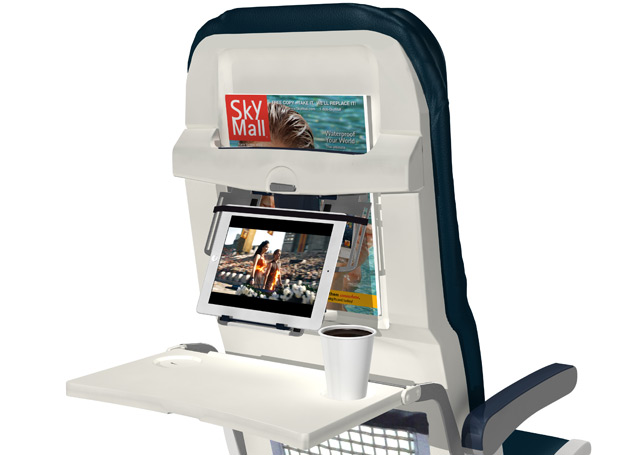Instructions can be found on the Internet to turn an air sickness bag into a smartphone holder, to enable passengers to view content on their own devices instead of watching airline-provided in-flight entertainment (IFE).
While this may sound extreme, the proliferation of personal electronic devices (PEDs) such as smartphones and tablet computers has led some companies to devote their resources to designing and manufacturing much more sophisticated ways of achieving the same goal.
Take Seattle, Washington-based Skycast Solutions, which designed the TrayVu Slim – a portable device featuring an 8.9in Samsung Galaxy tablet attached to a stand that clips on to the tray table. The idea is that passengers are able to watch IFE content on the tablet while keeping the tray table free for its intended purpose. Skycast has since replaced the TrayVu Slim with the smaller TrayVu7, which features a 7in Galaxy tablet. The TrayVu7 is being used by Canadian carrier WestJet as an IFE solution on board nine of its Boeing 737-800s.

Skycast Solutions
But Skycast’s latest invention – and the one it seems most excited about – is the TabCaddy, a device to hold tablets and smartphones of all sizes, which can easily be fitted to the back of an aircraft seat. Multiple corner straps hold the electronic devices in place, and the holder can be adjusted to provide the optimum viewing angle.
“The TabCaddy is geared towards airlines who want to install something lightweight on the back of the seat to store personal electronic devices,” says Skycast president Greg Latimer. Installation can be accomplished overnight, with no modification to the seat required. The fact that installation does not require “holes to be punched in the seat” means the TabCaddy is “going to be quite easy to certify”, according to Latimer.
The company spent the last nine months developing a TabCaddy specifically for use on Recaro Aircraft Seating’s best-selling BL3520 economy class seat, which it will unveil at the Aircraft Interiors Expo in Hamburg in April. It is also developing a TabCaddy “that can be used on a whole range of seats”, says Latimer.
“We’ve shown the prototype to two airlines and they both want it,” says Latimer. “This is an enormous issue – everyone’s bringing their PEDs on board. Even when you have embedded IFE, [passengers] still have their tablets out.”
Skycast is looking at retrofitting existing Recaro seats with the TabCaddy, but Latimer points out that “in the future, if seat manufacturers want to integrate our product, we could do that”.
Recaro chief executive Mark Hiller says he “can’t talk about co-operation with different companies”, but confirms that the German seat manufacturer will bring “an evolution of the BL3520 that is even lighter, and one major option will be a tablet holder”, to the Hamburg show. The holder, which is in the process of being certificated, attaches to the “upper end of the backrest”, and “will allow passengers to use the table at the same time”, says Hiller. “We see a lot of demand in the market for a tablet holder, especially in the short- and medium-range market,” he adds.
Skycast Solutions’ original design, which Latimer believes was “ahead of its time”, was the TrayVu, an IFE system which is embedded into the tray table itself. It features a fully configured tablet computer built into the tray table, but the product remains uncertificated, and appears to have been put on the back burner while the company shifts its focus to the portable PED market. However, Latimer says: “We’re still marketing the TrayVu because we still believe the most innovative way to use the tray from an IFE perspective is an integrated tray that gets it out of the seat.”
Another company looking to turn the humble tray table into a comfortable place for passengers to use their tablets is Smart Tray International. The Arizona-based firm says it is “transforming ordinary food tray tables into work and play stations, theatres, libraries and stowage compartments for tablet devices, with lots of room left for snacks and drinks”.
Smart Tray’s most basic design, the X1, includes a “proprietary groove” built into the table to provide a hands-free spot in which to stand a tablet device. The slightly more complex X2 features a flap in the centre of the tray table which holds a tablet in an upright position, but can be folded back down to provide a flat surface for eating and drinking. The third design, the X3, holds non-removable tablets, and is being marketed as an alternative solution to embedded IFE systems.
Source: Flight International
















